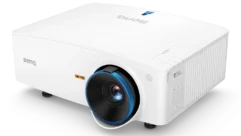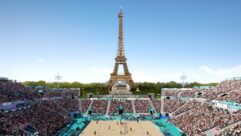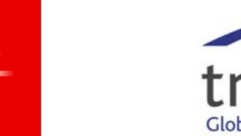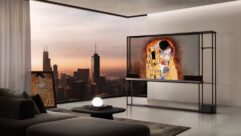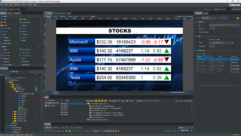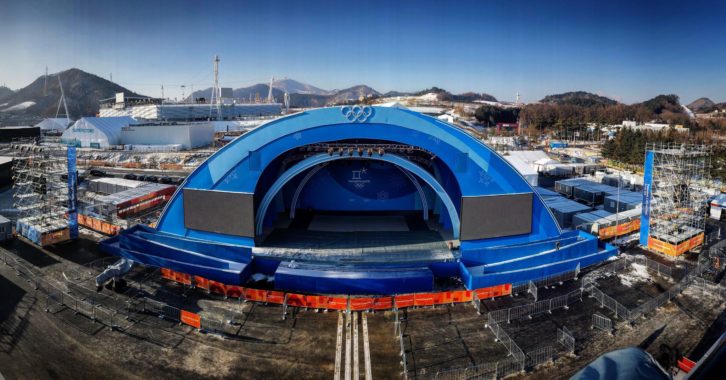
To prepare for the 2018 Winter Olympics, South Korea built six new venues and refurbished six others in three different areas in the province: PyeongChang, an area known for winter sports and home to the Olympic Stadium; Jeongseon, a former mining area home to the downhill skiing courses; and Gangneung, a resort town and bustling port city home to the ice skating, speed skating, and hockey arenas.
One of the largest AV (and broadcast) suppliers for the sprawling games was of course Panasonic, which reports supplying a total of 1640 square meters of LED display in the competition venues, in addition to approximately 80 PT-RZ31K high-brightness compact 30,000 lumens projectors for the opening and closing ceremonies, 154 other projectors, 1079 security cameras, 20 camera recorders, 16 multi-format live switchers, and audio systems for 10 venues.
But alongside the large-scale anchor vendors, there were dozens of other technology suppliers whose products served as infrastructure and playback and solved problems or enhanced the guest experience for those who made the trip to South Korea. Here are just a few examples of the Olympics’ technology moments, gathered from my inbox. –Cynthia Wisehart
EAW Adaptive System

The Medals Plaza stage within the PyeongChang Olympic Plaza hosted cultural performances and video displays of the competition during the day and Olympic medal ceremonies in the evening. Playback for these important events at this iconic location was reinforced by an Eastern Acoustic Works (EAW) Adaptive System provided by Seoul-based Dasan SR.
The one-floor Medal Plaza – at 1,267 square meters in size – features a wide, domed stage and an audience area wider than it is deep. The challenge, EAW says, was to blanket the outdoor area with clean, high-quality sound while providing the flexibility required for the different forms of entertainment.

To accomplish this, Dasan SR specified left-right columns of four Anna modules hung above the stage video screens (covered by scrim to match the dome). Large scaffolding towers were erected further left and right of the stage for the main PA, which was made up of 20 Anya modules. Two columns of five Anya modules hang in each scaffold.
A combination of twelve Otto subwoofers – ground stacked 2 x 3 – located under each Anya array along with four SB1002 subs placed under the stage provide the low end that the programming demands. Six KF730 enclosures were placed along the lip of the stage for front fill while 16 MicroWedge stage monitors were on hand for the artists.
K-ARRAY Python

Gangneung Ice Arena served as the venue for both the figure skating and short track speed skating competitions. The arena houses two 60m x 30m ice rinks for competition and training respectively, and has a seating capacity of 12,000.
Because the arena reaches four floors aboveground in height, Olympic organizers needed an audio system that was precise and powerful for both the audience and the figure skaters performing to music.
Organizers asked South Korean distributors, Soundus to supply an audio design and specification that would provide the necessary breadth and accuracy. Their design included K-Array PythonKP52 line arrays, chosen for clarity and definition and an ability to provide continuous, even coverage that reaches the last bleacher in the stands.

Equipped with Pure Array Technology (PAT), the Python has no crossover points in the voice range and no reflex ports. Only the closely-spaced, full-range 3” identical sound sources are responsible for the Python’s true line array characteristics. It claims a perfect phase response both in the near and in the far fields and as a compact column it provided the necessary uniformity for the stadium seating in the arena.
A total of 56 Python line arrays were installed horizontally throughout the bleachers to successfully provide accurate audio without obstructing the view of the competitions.
Clear-Com Communications

Sometimes technology that defines guest experience is invisible to the guests themselves. Proper communications during Olympics venue operations are of paramount importance to everyone involved.
At the 2018 PyeongChang Olympics, the team at The P.A. People and OneUp Solutions ensured that the Clear-Com systems in use kept a large portion of key venue personnel in touch before, during, and after events.
The Clear-Com system is used for the sports A/V presentation in the venue. Timing and results all link back to Olympics Broadcasting Service (the host broadcaster which supplies images and sounds to all the partner broadcast organizations) and into the actual sport federation itself, says Scott Davidson, senior systems engineer, Event Communications, The P.A. People. “We also have three venues here that are fiber-trunked together, and that provides some real good flexibility to join the three systems together while also giving autonomy.”

Chris Dodds, managing director, The P.A. People, notes that every system has three major components: the Matrix, the Partyline, and the FreeSpeak devices. “To our knowledge,” he adds, “this is the first time that serious quantities of full-duplex comms have been used for an Olympics.”
At each of 15 locations, a mix of Clear-Com intercom systems are deployed, including the Eclipse HX matrix system as a central system, FOR-22 module cards for two-way radio interfacing, LQ-R4W8 IP interface for eight rings of audio interface to HelixNet, HelixNet Digital Partyline Main Stations, and a FreeSpeak II Base Station or E-QUE card.
Field equipment used by the operators includes 400 FreeSpeak II wireless intercom beltpacks and headsets (for mobile users), 115 FreeSpeak II transceivers and 30 splitters, 180 V-Series Lever keypanels, 440 HelixNet digital beltpacks, 100 CC110 lightweight headsets, 100 CC200 lightweight headsets, 500 CC300 headsets, and 300 CC400 headsets.

Sydney-based The P.A. People has the world’s largest Clear-Com rental inventory and worked with Korea-based OneUp Solutions on the project. The systems are not cookie-cutter and require different quantities of certain elements (particularly at the endpoints), and Davidson says the flexibility of the system and the HelixNet beltpacks has been good for all involved.
All of the endpoints are IP-capable, so the system can depoly using network switches for all elements. HelixNet adds to that versatility because uniquely every channel of the Partyline system can share one cable and select the required channels at the beltpack.
Leyard TWS Series

For NBC Olympics, a division of the NBC Sports Group, Leyard supplied three TWS Series LED video walls for the dramatic set within the International Broadcast Center.
The Leyard video walls include a 43-foot wide by 13-foot tall video wall comprised of 196 displays, a 16-foot wide by 8-foot tall video wall comprised of 36 displays, and three 4-foot wide by 7-foot tall video walls in an athlete interview area.
The walls uniquely integrated with the scenic design that soon became familiar to Olympic viewers at home, and of course to all the athletes summoned there for interviews.
Stateside Olympics AV
Beyond the guests who enjoyed the 2018 Winter Olympics in person, and the millions who tuned in via television and internet, Olympic distribution got a new audience and a new twist with the first-ever public DOOH network featuring Olympics content.
NBC Olympics partnered with smart cities technology pioneers and media company Intersection to show exclusive content of the PyeongChang Olympics across four thousand large format digital screens in public places in the U.S. throughout the winter games. This is the first time the official Olympics broadcaster is cutting content specifically for the digital out-of-home medium. The Olympics content was seen in New York City, Chicago and Philadelphia during its production of the XXIII Olympic Winter Games.
LynkNYC, the public screen-based system in New York City–the largest and fastest free public Wi-Fi network in the world according to Intersection—was part of the program. LinkNYC was one of the first smart cities networks based on interactive screens in the U.S., It has always had a substantial public access component that went beyond a passive “digital signage” model and towards more civic engagement especially for demographics with less mobile internet access.

The custom content for the 2018 Winter Games, specifically created for Intersection’s urban network of digital screens, will keep people up-to-date on the PyeongChang Olympics. The program will feature morning highlights, primetime previews, an Opening Ceremony teaser, medal counts, real-time alerts, athlete profiles and more, spanning thousands of screens across the LinkNYC network in New York City; digital urban panels and platform displays in the Chicago Transit Authority; and digital bus shelters, urban panels and platform displays throughout SEPTA, PATCO and the streets of Philadelphia.
“Whether walking the streets of New York, riding the Chicago L, or waiting in Philadelphia’s 30th Street Station, Olympics fans in these three cities will be surrounded by the excitement of the Winter Games,” said Gary Zenkel, President, NBC Olympics. “Emerging media platforms like the LinkNYC network in New York City represent another way for NBCUniversal to reassemble the television audience by extending the reach of our Olympic coverage, content and promotion to spaces where the American audience now consumes media.”
“Our content partnership reflects a new approach to storytelling in cities using one of the most inspiring and unifying global events,” said Ari Buchalter, CEO of Intersection. “With thousands of digital screens across our cities and transit hubs, our partnership allows us to bring NBC’s coverage of the Winter Games to fans in entirely new ways, and create unique content and advertising experiences for consumers.” –David Keene


